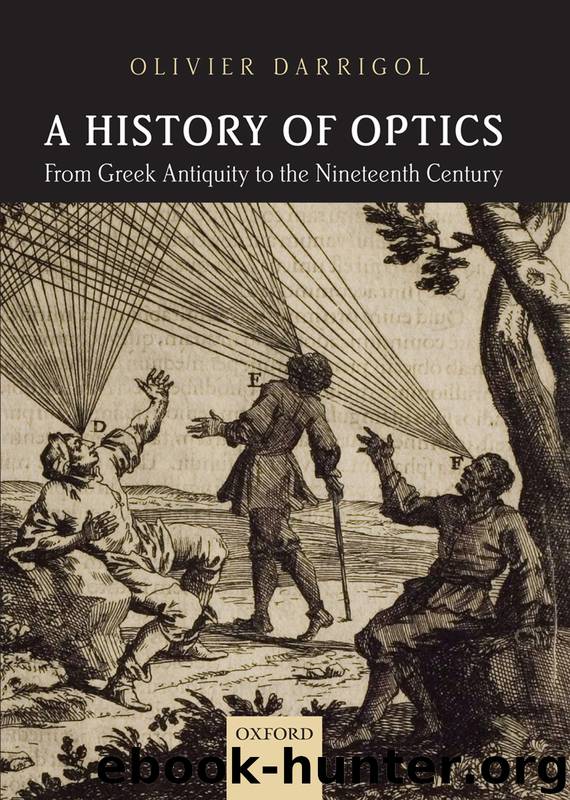A History of Optics from Greek Antiquity to the Nineteenth Century by Darrigol Olivier

Author:Darrigol, Olivier
Language: eng
Format: epub
Publisher: OUP Oxford
Published: 2012-04-16T04:00:00+00:00
Crucial experiments
In 1803, Young gave his third Bakerian lecture, the second of those devoted to physical optics. His main new result was “an experimental demonstration of the general law of the interference of light.” Although “the ingenious and accurate Grimaldi” had long ago observed fringes in the shadow of a narrow rectangular blade, this phenomenon had generally been overlooked owing to Newton’s failure to notice it. Young not only studied these fringes with unprecedented accuracy, but he realized that they disappeared when the light passing on one side of the blade was blocked. In his opinion, this observation provided a direct proof of interference since it demonstrated the necessity of light traveling through two different paths. The Newtonian explanation by differential inflection near the edges of the blade failed, since the inflection on one side of the blade could not plausibly depend on the other side. In contrast, the law of interference immediately explained the equal spacing of the fringes in the plane of observation as well as their hyperbolic trajectory when the distance of this plane from the blade grew.48
Whereas Young had earlier justified interference by acoustic analogy, he now regarded the law of interference as establishing the analogy between light and sound:
For, hitherto, I have advanced in this Paper no general hypothesis whatever. But, since we know that sound diverges in concentric superficies, and that musical sounds consist of opposite qualities, capable of neutralising each other, and succeeding at certain equal intervals, which are different according to the difference of the note, we are fully authorised to conclude, that there must be some strong resemblance between the nature of sound and that of light.
Moreover, Young abandoned the Newtonian concept of inflection that he had used in his earlier accounts of diffraction. He now declared:
I have not, in the course of these investigations, found any reason to suppose the presence of such an inflecting medium in the neighbourhood of dense substances as I was formerly inclined to attribute to them; and, upon considering the phenomena of the aberration of the stars, I am disposed to believe, that the luminiferous ether pervades the substance of all material bodies with little or no resistance, as freely perhaps as the wind passes through a grove of trees.
According to this poetical metaphor, the ether could not accumulate in the vicinity of material bodies, so that inflecting atmospheres à la Mairan could not exist.49
The famous experiment of Young’s holes or slits appears in Young’s Lectures of 1807. It provides the simplest illustration of the principle of interference, since the two holes materially determine the paths of the interfering portions of light. It is also the optical counterpart of a case of water-wave interference described in the Lectures (Fig. 5.5). In conformity with his use of the phrase “undulatory theory of light,” Young now made water waves the central metaphor for any wave process:
Download
This site does not store any files on its server. We only index and link to content provided by other sites. Please contact the content providers to delete copyright contents if any and email us, we'll remove relevant links or contents immediately.
Enlightenment Now: The Case for Reason, Science, Humanism, and Progress by Steven Pinker(7233)
A Journey Through Charms and Defence Against the Dark Arts (Harry Potter: A Journey Through…) by Pottermore Publishing(4781)
The Immortal Life of Henrietta Lacks by Rebecca Skloot(4525)
A Journey Through Divination and Astronomy by Publishing Pottermore(4344)
Elon Musk by Ashlee Vance(4028)
Origin Story: A Big History of Everything by David Christian(3648)
COSMOS by Carl Sagan(3554)
Alchemy and Alchemists by C. J. S. Thompson(3449)
Bad Pharma by Ben Goldacre(3356)
Enlightenment Now by Steven Pinker(3338)
Shadow of Night by Deborah Harkness(3302)
Inferior by Angela Saini(3276)
A Mind For Numbers: How to Excel at Math and Science (Even If You Flunked Algebra) by Barbara Oakley(3218)
Origin Story by David Christian(3147)
The Code Book by Simon Singh(3074)
Signature in the Cell: DNA and the Evidence for Intelligent Design by Stephen C. Meyer(3071)
The Elements by Theodore Gray(2998)
A Brief History of Time by Stephen Hawking(2960)
A Journey Through Potions and Herbology (A Journey Through…) by Pottermore Publishing(2828)
